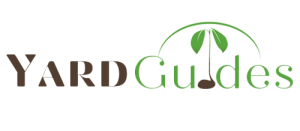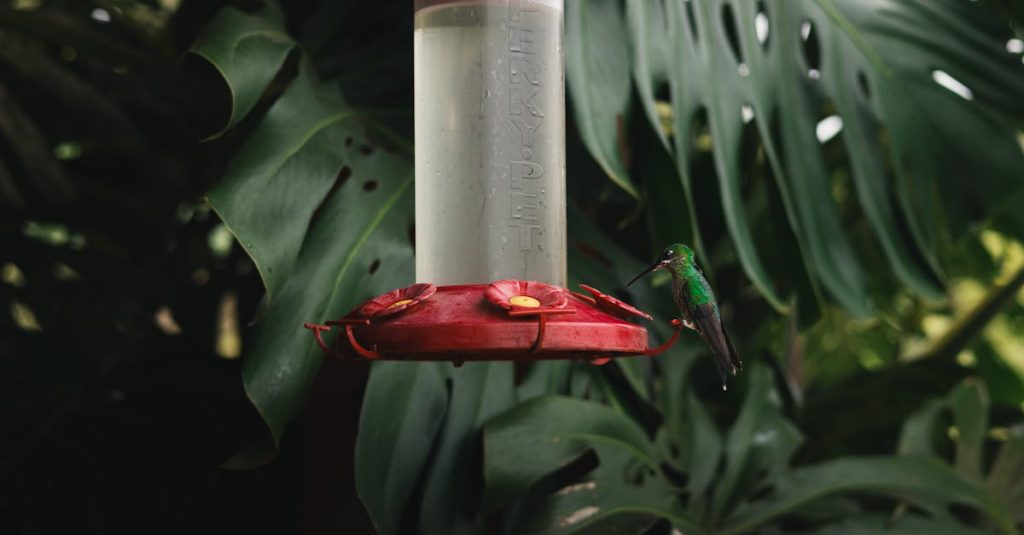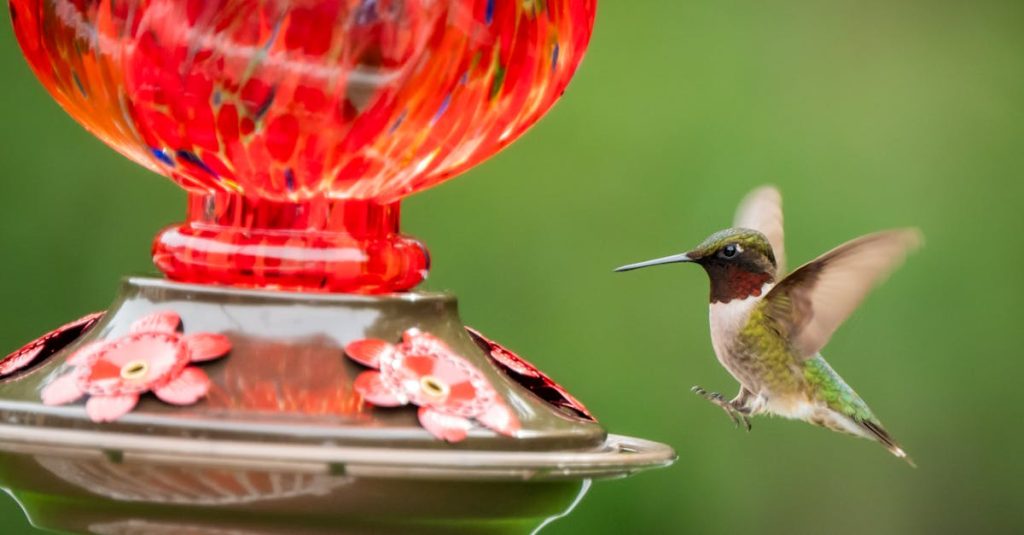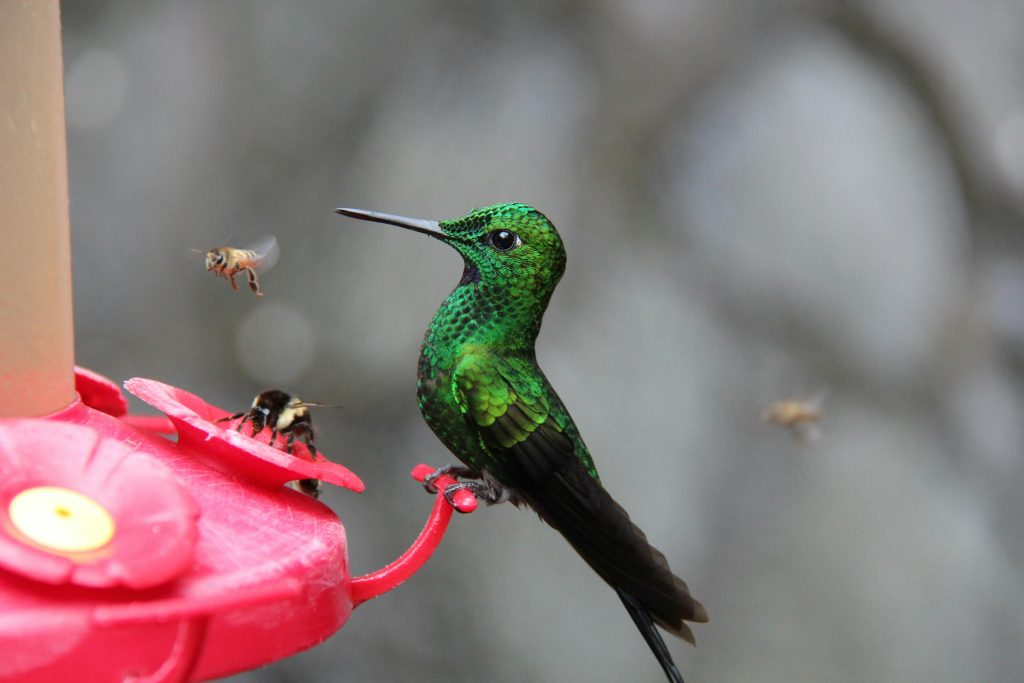Hummingbirds bring vibrant life to urban gardens. Their presence is a sign of a healthy ecosystem. But maintaining this requires clean hummingbird feeders.
Mold in hummingbird feeders is a common issue. It poses a risk to these delicate birds. Regular cleaning is essential to prevent mold growth.
Urban landscapers often face challenges in keeping feeders clean. Understanding the best cleaning practices is crucial. This ensures a safe feeding environment.
Using the right cleaning solutions is key. Vinegar and bleach are popular choices. Each has its pros and cons.
This guide will walk you through effective cleaning methods. You’ll learn how to keep feeders mold-free. Let’s ensure our urban spaces support thriving hummingbird populations.
Why Clean Hummingbird Feeders Matters: Health, Mold, and Urban Biodiversity
Hummingbird health depends heavily on clean feeders. Contaminated feeders pose health risks. Mold can lead to illness in these birds.
Mold is particularly harmful to hummingbirds. It affects their immune systems and can even be fatal. Addressing this promptly is crucial.
Urban biodiversity thrives with the right conditions. Clean feeders contribute to this diversity. They attract not only hummingbirds but also other pollinators.
Maintaining clean feeders is more than just a task. It’s a commitment to supporting urban ecosystems. Here’s why cleaning matters:
- Prevents diseases in hummingbirds
- Supports a healthy urban pollinator population
- Enhances urban biodiversity
By regularly cleaning feeders, you play a part in a larger ecological balance.

Identifying Mold in Hummingbird Feeders: Signs and Risks
Mold in hummingbird feeders is a stealthy threat. It often appears as black spots. These spots are commonly found on feeder surfaces or in the nectar.
The risks of mold go beyond mere aesthetics. Mold can impair hummingbird health. It introduces harmful toxins, impacting digestion and overall wellness.
Detecting mold early is important. Keep an eye out for these common signs:
- Black mold patches
- Cloudy nectar
- Discolored feeder parts
Regular checks can help you address mold before it becomes dangerous. Preventing mold growth is key to ensuring the feeders remain a safe haven.

What to Use to Clean Hummingbird Feeders: Safe and Effective Solutions
Choosing the right cleaning agents is crucial for your feeders. Opt for non-toxic solutions to protect hummingbirds from harm. Vinegar and bleach are commonly used options.
Vinegar is a natural cleaning agent. It’s effective in removing mold without leaving harmful residues. It’s also eco-friendly and readily available.
Bleach is another option but requires caution. It effectively kills mold, yet must be rinsed thoroughly to avoid any chemical residues that can harm birds.
Here’s a list of recommended cleaning solutions:
- White vinegar (one part vinegar to four parts water)
- Diluted bleach (one part bleach to nine parts water)
- Bottled or distilled water for rinsing
Always remember to rinse the feeder thoroughly. Using clean water ensures all cleaning agent residues are removed. This step is vital for maintaining a healthy feeding station.

Step-by-Step: How to Clean a Hummingbird Feeder with Mold
Cleaning hummingbird feeders might seem daunting, especially when mold is involved. However, following a structured process can simplify this task. Here’s a step-by-step guide to effectively tackle mold in your feeders.
First, gather your materials. You’ll need white vinegar or bleach, a soft bottle brush, and a clean, dry towel. Make sure that everything is ready before disassembling the feeder.
Start by taking apart the feeder. Remove all parts, including lids, perches, and bases. This ensures that you can clean each component thoroughly.
Next, prepare your cleaning solution. For a vinegar solution, mix one part vinegar with four parts water. If using bleach, use one part bleach to nine parts water. Soak the components in this mixture for several minutes.
While the parts are soaking, use a bottle brush to scrub away visible mold and nectar residue. Pay special attention to the inside of the feeder, where mold can thrive.
Rinse all parts meticulously with clean, running water. This step is crucial when using bleach as it helps remove any leftover chemicals. Ensure no residue remains.
Once rinsed, lay the parts on a towel to air dry completely. Avoid using dish towels, as these can sometimes harbor bacteria. Letting everything dry naturally reduces the risk of mold growth.
Finally, reassemble the feeder. Check each part for any remaining mold or damage. Once confirmed clean and dry, the feeder is ready for fresh nectar and eager hummingbirds.
In summary, maintaining a clean feeder protects hummingbirds and enhances urban biodiversity. By adhering to these steps, urban landscapers can uphold healthy habitats within garden designs.


Cleaning with Vinegar vs. Bleach: Pros, Cons, and Best Practices
Choosing between vinegar and bleach for cleaning hummingbird feeders often depends on the condition of the feeder and personal preference. Both agents have their advantages and potential drawbacks.
Vinegar is a natural cleaning option that minimizes environmental impact. It is safe for birds when properly used and rinsed, making it a preferred choice for many wildlife gardeners.
Conversely, bleach is potent against stubborn black mold and effectively disinfects feeders. However, it requires thorough rinsing due to its chemical nature, ensuring no harmful residues linger.
For those considering which to use, here’s a quick comparison:
- Vinegar Pros: Eco-friendly, non-toxic, readily available
- Vinegar Cons: May require longer soaking for tough mold
- Bleach Pros: Highly effective on persistent mold
- Bleach Cons: Needs extensive rinsing, potential chemical exposure
To maximize efficiency, choose cleaning agents based on the severity of mold and the frequency of cleaning. Regular, lighter cleanings might suit vinegar, while deep cleans could warrant bleach.

How Often to Clean Hummingbird Feeders: Schedules for Every Season
Regular cleaning of hummingbird feeders is crucial to bird health and feeder longevity. Cleaning frequency can vary depending on climate and season.
During warmer months, feeders should be cleaned every 2-3 days. Heat accelerates mold and bacteria growth, risking bird health.
As temperatures cool, you can extend cleaning to weekly, thanks to slower mold formation. Here’s a simple guideline:
- Summer: Clean every 2-3 days
- Spring/Fall: Clean every 4-5 days
- Winter: Clean weekly, unless warmer conditions persist
Always adjust based on weather conditions and feeder usage. Frequent refilling helps monitor nectar freshness and potential issues.

Preventing Mold in Hummingbird Feeders: Pro Tips for Urban Landscapers
Preventing mold in hummingbird feeders is essential for maintaining a healthy environment for these fascinating birds. Mold can be harmful and discourages hummingbirds from visiting your urban garden.
To keep mold at bay, position feeders in shaded locations. Direct sunlight speeds up fermentation of sugar solutions, increasing mold risks.
Opt for feeders with wide openings. They allow easier access for cleaning, reducing mold build-up.
Regularly change the nectar, even if it seems untouched. Fresh nectar every few days prevents fermentation.
Consider these mold prevention tips:
- Use feeders with simple designs.
- Avoid placing feeders near damp spots.
- Keep feeders filled with small amounts, refilling as needed.
Implementing these strategies helps maintain clean, attractive feeders. This promotes a vibrant, urban landscape filled with hummingbirds.

Choosing the Best Hummingbird Feeder for Easy Cleaning
Selecting a feeder designed for easy maintenance is key to supporting urban biodiversity. Opt for models with detachable components. This ensures all parts can be cleaned thoroughly.
Look for feeders with smooth surfaces. Textured areas can trap dirt and mold more easily. Simplicity in design also aids in hassle-free cleaning.
Consider these features when choosing a feeder:
- Wide openings for easy access
- Smooth, non-textured surfaces
- Detachable parts for thorough cleaning
By choosing a feeder that meets these criteria, you make routine cleaning simpler, which is crucial for attracting more hummingbirds to your garden.

Common Mistakes to Avoid When Cleaning Hummingbird Feeders
Cleaning errors can unintentionally harm hummingbirds. One common mistake is not rinsing well enough after cleaning. Residual cleaning agents may be harmful.
Another misstep is using soap on feeders. Soap leaves behind residues that are dangerous for birds. Always choose non-toxic solutions instead.
Watch out for ignoring crucial areas during cleaning. Mold often hides in crevices and corners, unnoticed.
Key mistakes to avoid:
- Failing to rinse thoroughly
- Using soap instead of safe cleaners
- Overlooking tiny spaces within the feeder
By steering clear of these errors, you will maintain a feeder that supports healthy hummingbird habits.

Integrating Feeder Cleaning into Urban Garden Design and Community Efforts
Incorporating feeder cleaning into garden design enriches urban biodiversity. Engage local communities to build a healthier ecosystem. Collaborative efforts increase community investment and awareness.
Make feeder cleaning part of regular garden care routines. This keeps gardens vibrant and inviting for pollinators.
Organize community cleaning days. These events foster teamwork and collective responsibility. Everyone benefits from a cleaner environment.
Consider the following strategies:
- Establish a shared cleaning schedule
- Host workshops on eco-friendly practices
- Collaborate with local wildlife groups
Enhancing garden design with feeder maintenance promotes both human and wildlife well-being.

Hummingbird Feeder Cleaning Checklist
Use this checklist to ensure thorough cleaning every time. Keeping feeders clean helps maintain a healthy hummingbird population.
Here’s a quick checklist:
- Disassemble feeder completely
- Soak parts in vinegar or bleach solution
- Scrub with a bottle brush
- Rinse thoroughly with clean water
- Air dry before refilling with fresh nectar
Follow these steps regularly to promote a safe feeding environment. Clean feeders encourage more vibrant urban wildlife interactions.
Resources and Further Reading
For more information on maintaining clean hummingbird feeders, check these resources. They provide detailed insights into feeder care and hummingbird conservation.
Recommended resources:
- “Attracting Hummingbirds: A Guide to Safe Feeding Practices” (Book)
- HummingbirdSociety.org (Website)
- “Hummingbird Gardens: Tips for Urban Landscapes” (Article)
Explore these to deepen your understanding and support biodiversity in your garden.



